#new caledonia
Text

New Caledonian Giant Gecko (Rhacodactylus leachianus), family Diplodactylidae, endemic to New Caledonia
This is the longest and heaviest gecko species in the world, growing up to 17 inches total length, and weighing up to 300 g.
Photo via: Coast To Coast Exotics Ltd
2K notes
·
View notes
Text
Ever Heard Of A Kagu? This Bird Lives In New Caledonia And Is Nearly Extinct.
2K notes
·
View notes
Text

Ouvea, New Caledonia
456 notes
·
View notes
Text
Mekosuchus walking in to shallow pond.

Samll and last land crocodile that lived in what is now new caledonia. Realy amazing lil fella.
#art#drawing#paleoart#mesozoic#paleontology#palaeoblr#paleomedia#prehistoric#science#mekosuchus#new caledonia#scifiart#speculative biology
213 notes
·
View notes
Text
Mekosuchus
My recent-most Wikipedia deep dive was in equal parts enlightening and frustrating and it concerned no other than Mekosuchus, everyones favourite heartbreaker of a recently extinct crocodile.
For those unfamiliar, let me give you some footnotes before getting into the nitty gritty. Mekosuchus is, or was, a genus of terrestrial (NOT ARBOREAL) dwarf crocodile from Australasia, first appearing during the Late Oligocene. They were small, how small we don't precisely know but its generally estimated that adults would be in the 1-2 meter range (so about 3 to 6 feet I believe?). The heartbreaking part? The last confirmed Mekosuchus died out only 3.000 years ago, and some publications even suggest they could have stuck around until just 1.700 years ago. Yeah, we got REALLY close.
Art by yours truly, I'll explain the massive difference down below, just be patient.

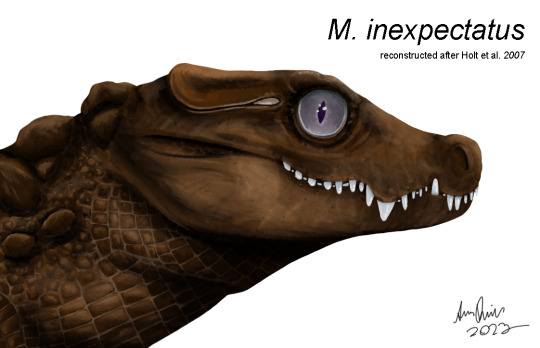
But lets get some of the basics out of the way. Mekosuchus was a small mekosuchine crocodilian and currently, four species are recognized. Mekosuchus whitehunterensis is the oldest from the Oligocene/Miocene of mainland Australia, immediately succeeded by M. sanderi during the Miocene. Both these species were described as having had blade-like posterior teeth (at the back of the jaw) and both coexisted with a ton of other crocs, including Baru, Quinkana and some bizarre ones like Ultrastenos.
After a bizarre break in the fossil record, Mekosuchus shows up again during the Holocene on the islands of New Caledonia and Vanuatu, ironically mirroring the meiolaniid turtles I talked about previously. Fossils are securely dated to about 3.000 years ago, but Balouet and Buffetaut also suggested that some of the younger remains may only be 1.720 years old, overlapping with human settlements. But this isn't accepted by everyone. Regardless, these species differ from their older cousins by lacking the blade-like teeth, instead going for crushing dentition.
Art by artbyjrc and Kahless28
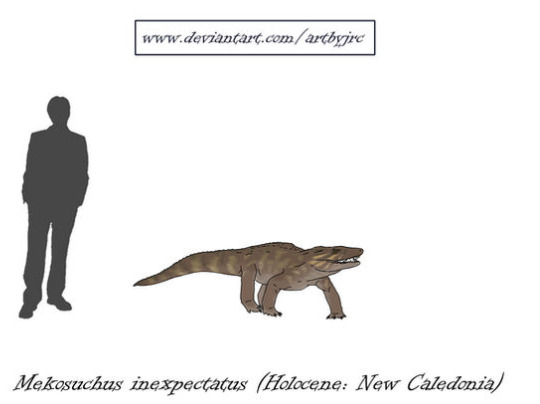

With such different teeth comes different ecology, of course. A 2015 study suggests that the neck vertebrae of M. whitehunterensis were well adapted to rapid stresses, specifically caused by side-to-side movement of the head. It is thus speculated that they shook their heads to strip meat from carcasses, rather than performing the iconic death roll (as that might hurt the animal on land).
M. inexpectatus meanwhile was seemingly better adapted at crushing hard-shelld things, crabs, insects, maybe snails even. Holt and colleagues suggest that it might have lived much like a modern dwarf crocodile, spending its time in river streams and coming out at night to forage.
Dwarf crocodile via the San Diego Zoo and Mekosuchus illustrated by my friend BatmanelVisigodo


Both however are thought to be terrestrial, having short, altirostral skulls, big eyes and nares that face sideways, not upwards as in semi-aquatic crocodilians. They were however NOT ARBOREAL. Yes I know I know, its a bummer. To those unaware, a commonly cited missconception is that Mekosuchus was a tree-dweller, which was originally suggested by Paul Willis in the 1990s. However, this was more of an off-hand comment at the time that certain people (including me in the past) have run with, causing it to spread and be almost considered fact by some. Hell, it says a lot when Mekosuchus, in many circles, is thought of as "that tree croc".
However, not only was Willis suggestion based on the now outdated notion that monitor lizards weren't around at the same time, later authors also note that the toes of Mekosuchus really don't show any adaptations to climbing specifically. So alas, it would seem that this was only a myth. But don't worry too much, sometimes crocs climb regardless, just not vertically up a tree.
Mekosuchus artwork by Manusuchus
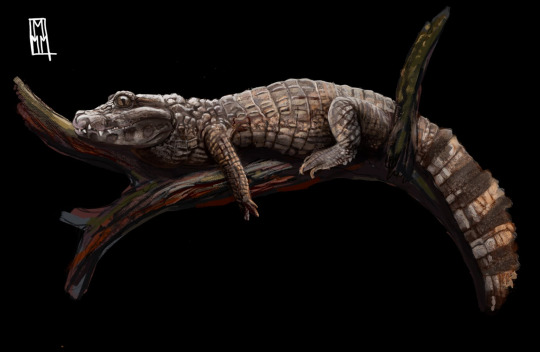

Now at the beginning I teased that there's a reason why my images for M. whitehunterensis and M. inexpectatus look so different. Well its kind of painful really. Despite being known for about 30 years now, with 300+ bones known from New Caledonia alone, Mekosuchus is incredibly poorly studied. The original description only figured around half a dozen bones and while the next three species were all named in the span of just 5 years, they are all incredibly fragmentary. And then, just after another expedition collected more bones....things went silent.
The last 20 years saw the publication of only a single paper extensively dealing with Mekosuchus itself, with two skull reconstructions coming out in less detailed sources.
The first is Holt et al. 2007, a powerpoint presentation from a paleontological conference. The presentation made some fascinating claims and even provided a reconstruction of the skull, but sadly. Nothing ever came of it, the research was never formally published and the lead author has since then changed fields into Astronomy. Actually had a nice talk with him earlier today.
Then there's Scanlon 2014, which offers even less. In the book Carnivores of Australia: past, present and future, Scanlon briefly touches upon mekosuchines, featuring a new composite reconstruction of M. whitehunterensis. However, this is not elaborated on in the text, despite the drastic differences to how M. inexpectatus has been reconstructed before. So we are left with two very different appearances. Are they simply really different looking species? Is one interpretation faulty? Should Mekosuchus be split? Who knows, might be a while until we figure it out. But until then, here's the two together, one looking much like a dwarf crocodilian, the other more like a sebecid. An interesting contrast for sure.

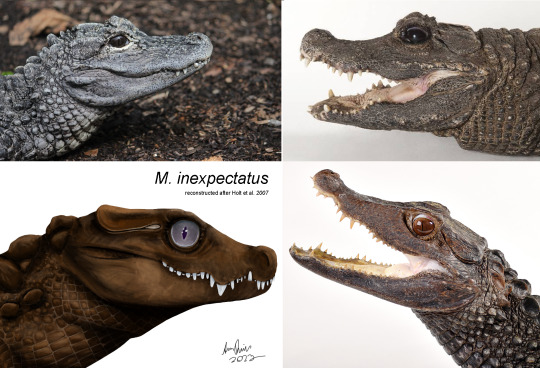
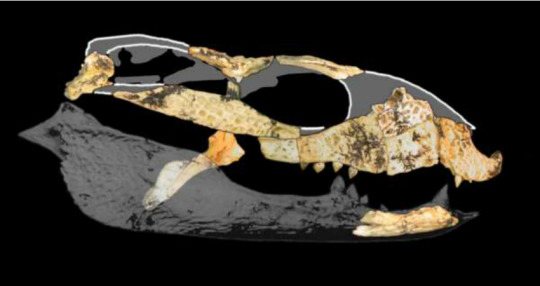
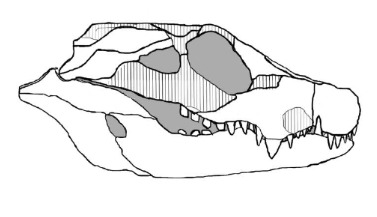
As per usual, this research was done as part of me doing a major haul of a Wikipedia page which you can read here Mekosuchus - Wikipedia. It's been an interesting, if a little frustrating task, but it was fun properly reading up on this animal and putting this information out there for people that don't wanna dig through 30 years of literature (including one paper in French).
Hopefully I suceeded, at least the page is a bit bulkier now.
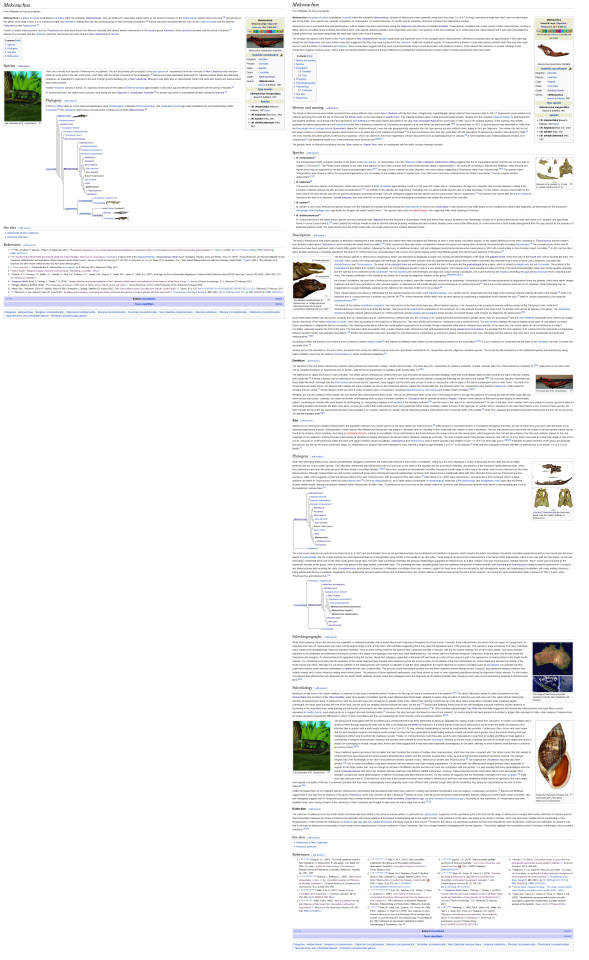
#wikipedia editing#palaeoblr#paleontology#prehistory#long post#crocodile#mekosuchus#land crocodile#mekosuchinae#new caledonia#extinction#paleo#science
182 notes
·
View notes
Text
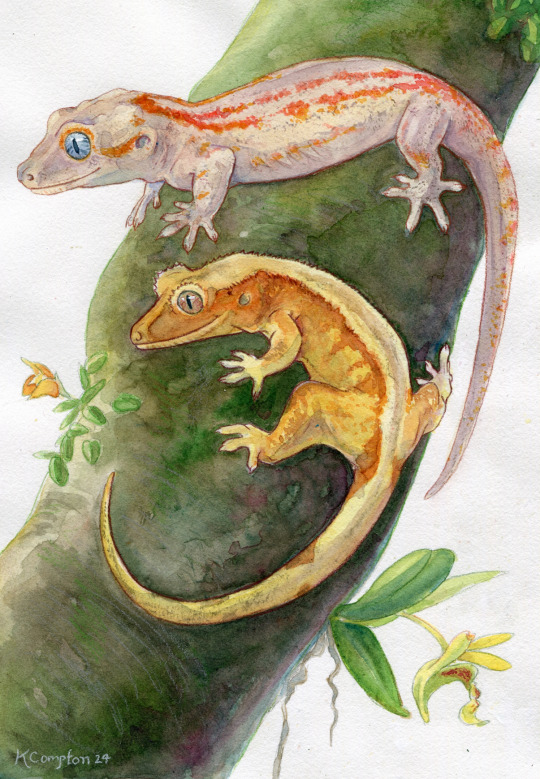
Finished 6"x9" watercolor gecko commission. Lots of room for improvement (and better brushes) but I'm satisfied. Featuring Hera the gargoyle gecko, Banana the crested, and Porpax karikouyensis on the left and Dendrobium ngoyense on the right, orchids that are native to New Caledonia where the geckos are from. (Not sure if the orchids are native to the geckos' specific islands buuuut whatever).
#commission#watercolor#gecko#crested gecko#gargoyle gecko#orchid#new caledonia#art#artists on tumblr#I traded this for a pair of tarantula slings!
74 notes
·
View notes
Text
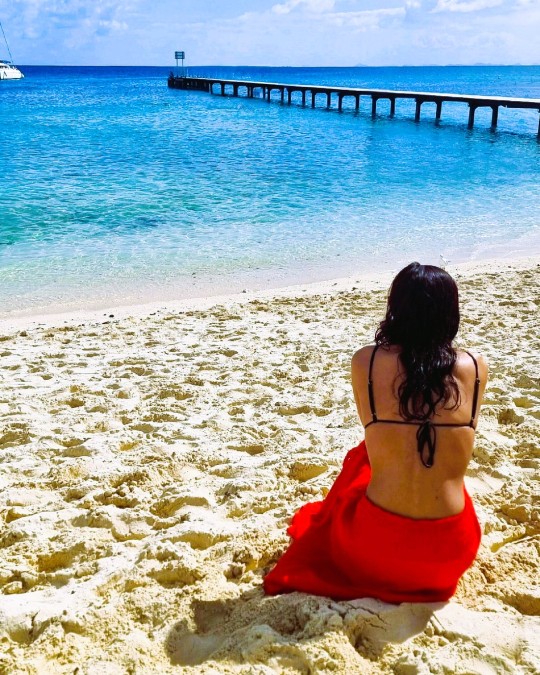
Signal Island, Îlot Maître Island, New Caledonia: Signal Island is just a spit of land about 10 miles west of Noumea, which translates to a 15-minute water taxi ride. Located less than 5 km from Ansa-Vata, the Master Islet is as popular with tourists as it is with Noumeans who like to go there to rest during the day. The only islet in Noumea to be equipped with a hotel, the Master Islet has a large reef nearly 2 km long. Very easily accessible from the beach of Anse-Vata by boat, the islet allows you to relax, but also to discover the flat with its turquoise and crystal clear waters.
36 notes
·
View notes
Text
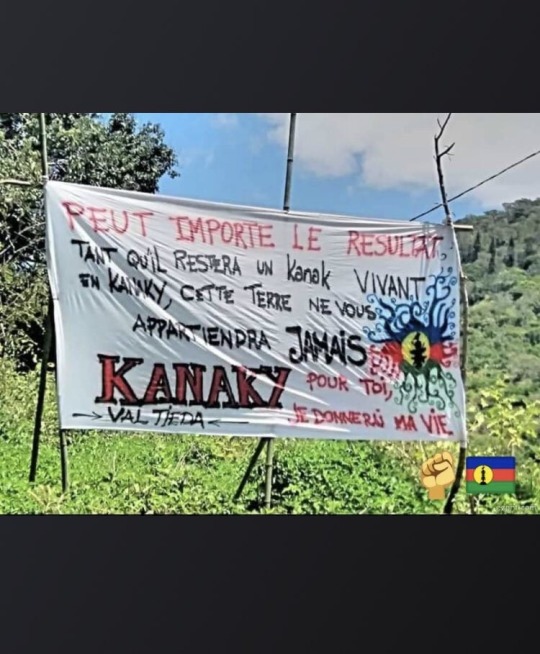
This is a sign during a protest in 2018 in Kanaky but it’s still up to date with the current situation and it applies to so many struggles against settler colonialism.
Translation: No matter the result, as long as there’s a kanak alive in Kanaky, this land will never belong to you. Kanaky, for you I would give my life.
Right now settlers are protesting harder trying to take over the land more than they already did. They are protesting calling indigenous people racists, attacking them and trying to change the voting rule so they can bring more settlers. Right now the rule is that if you or your parents didn’t have the right to vote in Kanaky in 1993 you cannot vote. It helps slowing down the impact of settlers by not giving the opportunity to settlers to just come and vote for their own interests against the interests of the indigenous people and settlers are not happy about it so they protest against Kanak people. (I’m over simplifying it cause I already made a post detailing the voting system in Kanaky (thinking about it the post might actually still be in my drafts))
Settler colonialism will end and the land will go back to indigenous people everywhere because indigenous people are fighting to take back what belongs to them.
P.S: while I’m on the topic of settler colonialism there’s good news about the resistance in Western Sahara too but I’m waiting for confirmation before sharing here.
#Kanaky#kanak#free Kanaky#settler colonialism#anti settler colonialism#new caledonia#France#French settler colonialism
25 notes
·
View notes
Text

Chasseurs P-38 dans les rues de Nouméa – Guerre du Pacifique – Nouvelle-Calédonie – France Libre – Novembre 1942
Le 12 mars 1942, les troupes américaines débarquent en Nouvelle-Calédonie, territoire de la France libre suite à l'appel du 18 juin du Général de Gaulle. La Nouvelle-Calédonie devient alors une importante base aérienne lors de la bataille de la mer de Corail et la base de lancement du Corps expéditionnaire américain pour la bataille de Guadalcanal. Nouméa devient le Quartier-Général du Pacifique.
#WWII#guerre du pacifique#pacific war#p 38 lightning#p 38#nouméa#noumea#nouvelle-calédonie#new caledonia#france libre#free france#11/1942#1942
15 notes
·
View notes
Text

🏖🏐
#kingok art#countryhumans#ch#countryhumans australia#countryhumans new zealand#australia#new zealand#countryhumans papua new guinea#papua new guinea#new caledonia#countryhumans new caledonia
20 notes
·
View notes
Text
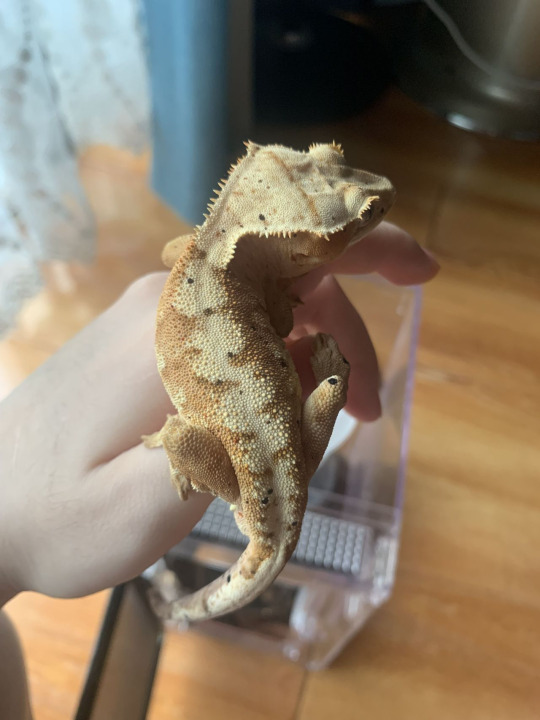
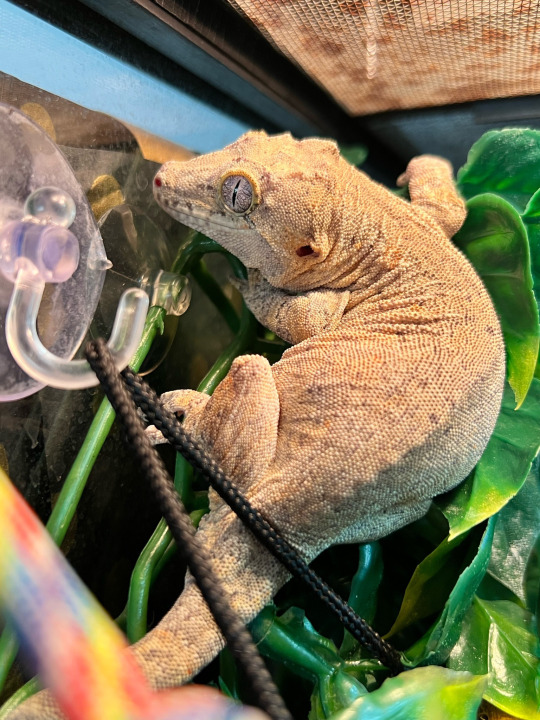
crested gecko + gargoyle gecko
33 notes
·
View notes
Text

New Caledonian Giant Gecko (Rhacodactylus leachianus), family Diplodactylidae, endemic to New Caledonia
This is the longest and heaviest gecko species in the world, growing up to 17 inches total length, and weighing up to 300 g.
Photograph by Jairo Cuevas (@jviridis)
#gecko#new caledonia#giant gecko#rhacodactylus#diplodactylidae#lizard#reptile#herpetology#animals#nature
1K notes
·
View notes
Text
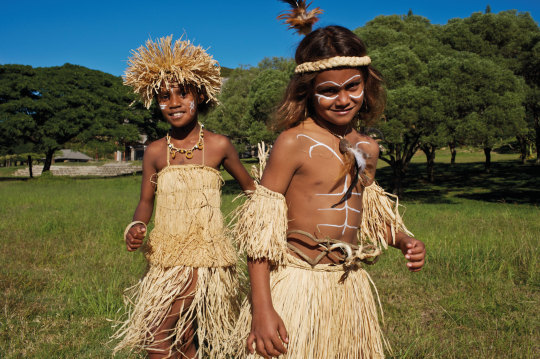
Kanak children, New Caledonia, by Voyage de Légende
#kanak#new caledonia#melanesia#oceania#folk clothing#traditional clothing#traditional fashion#cultural clothing
159 notes
·
View notes
Text

Isle of Pines, New Caledonia
68 notes
·
View notes
Text

French rugby
13 notes
·
View notes
Photo

Dumbéa - New Caledonia - France (by gérard)
#Dumbéa#New Caledonia#France#Frankreich#Europe#Nature#Landscape#Outdoor#Rural#Countryside#View#Viewpoint#Island#Photography#Travelling#Traveling#Travel#Tourism#Holiday#Urlaub#Reisen
298 notes
·
View notes